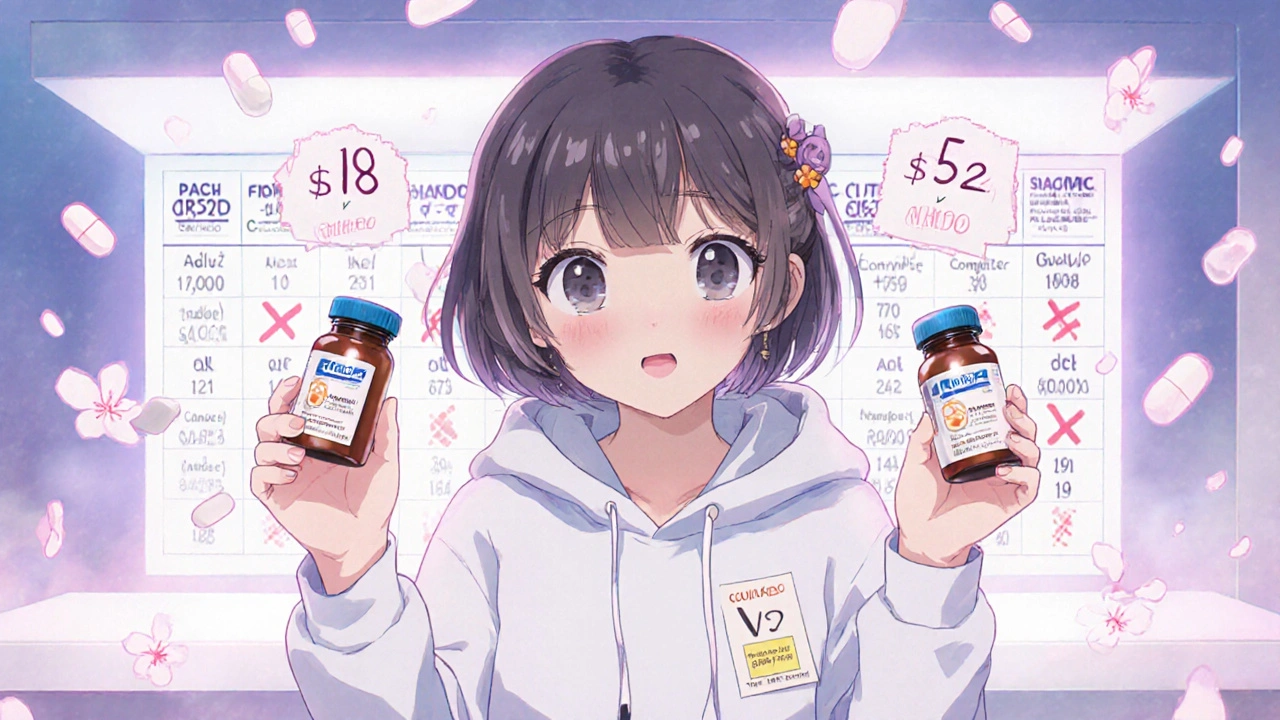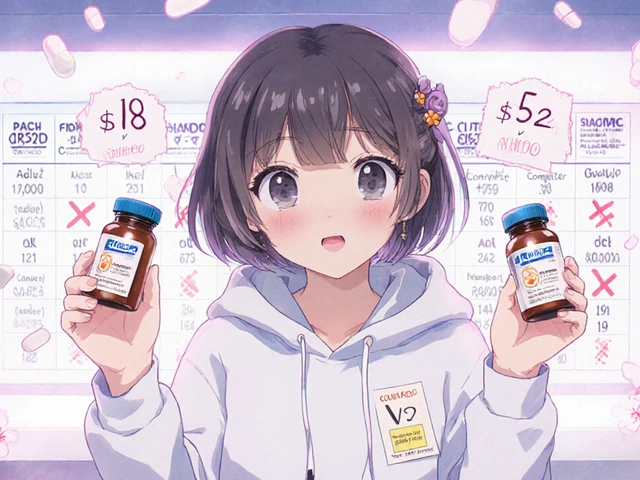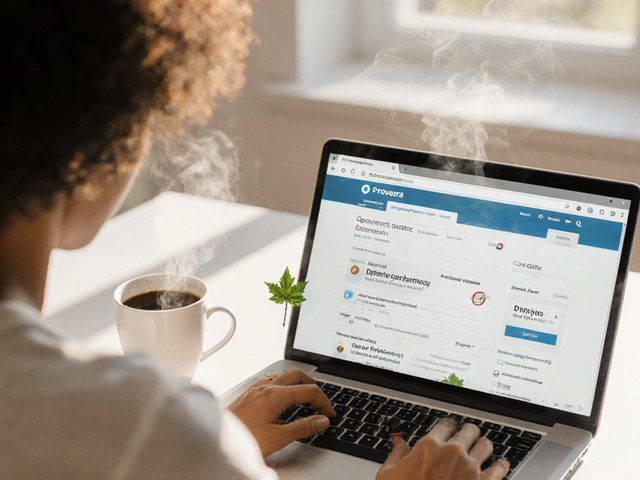When you’re on multiple medications, your pharmacy bill can feel like a puzzle with missing pieces. You might think buying two cheap generic pills is cheaper than one combo pill-until you see the receipt. The truth? It’s not always that simple. Insurance plans don’t just look at the price of each pill. They look at how they’re packaged, what tier they’re on, and whether your plan even covers the combo version at all.
Why Insurance Plans Love Generic Drugs
Nearly 90% of all prescriptions filled in the U.S. are for generic drugs. That’s not because doctors are pushing them-it’s because insurance companies make them the easiest and cheapest option. Generic versions of brand-name drugs cost 80% to 85% less on average. For drugs with six or more generic makers, prices can drop by 95%. That’s why Medicare Part D and private insurers almost always put generics in Tier 1-the lowest copay tier. For example, if you take a generic blood pressure pill, your copay might be $0 to $5. The same drug as a brand name? $47 to $112. It’s no surprise that 84% of Medicare Part D plans in 2019 only covered generics and blocked the brand versions entirely. Insurers don’t just prefer generics-they actively discourage brand-name use unless there’s no alternative.What’s a Generic Combination Drug?
A generic combination drug is a single pill that contains two or more active ingredients, all in generic form. Think of it like a multivitamin for your health condition. Common examples include:- Hydrochlorothiazide + lisinopril (for high blood pressure)
- Metformin + sitagliptin (for type 2 diabetes)
- Simvastatin + ezetimibe (for high cholesterol)
When the Combo Costs More Than Two Separate Pills
Here’s where things get confusing. Sometimes, your plan covers the two individual generic pills at $10 each ($20 total), but the combo version costs $50-even though it contains the exact same ingredients. How is that possible? It comes down to how your plan’s formulary is built. Some insurers treat combo drugs as a separate category. If the combo version isn’t on their preferred list, they may charge you more-even if the individual generics are covered. This happens most often when:- The combo drug is newer to the generic market
- The manufacturer hasn’t negotiated a good deal with your pharmacy benefit manager (PBM)
- Your plan hasn’t updated its formulary yet
How Tiered Formularies Decide What You Pay
Every Medicare Part D and private plan uses a tiered system. Here’s how it usually breaks down:| Tier | Drug Type | Average Copay |
|---|---|---|
| Tier 1 | Preferred generics | $0-$5 |
| Tier 2 | Non-preferred generics | $10-$15 |
| Tier 3 | Preferred brand-name drugs | $40-$60 |
| Tier 4 | Non-preferred brand-name drugs | $70-$100 |
| Tier 5 | Specialty drugs | $100+ |

What You Can Do to Save Money
You don’t have to accept whatever your plan says. Here’s how to fight back:- Check your plan’s formulary-every year during open enrollment. Look up your exact drug names, including the combo and the individual components.
- Ask your pharmacist-they have access to real-time pricing. They can tell you if buying two generics is cheaper than the combo.
- Ask your doctor to write separate prescriptions-if the individual generics are cheaper, your doctor can prescribe them separately. This is legal and common.
- File a coverage determination-if your plan denies the combo but you need it, your doctor can submit a request. It takes 72 hours for a standard review, or 24 hours if it’s urgent.
- Use the Medicare Plan Finder-enter your drugs and zip code to compare plans side by side. You might find a better deal next year.
The Big Change in 2024: No More Deductible, $2,000 Cap
Starting January 1, 2024, the Inflation Reduction Act changed everything for Medicare Part D users. The annual deductible is gone. And your out-of-pocket spending for all drugs-brand or generic-is capped at $2,000 per year. That means the difference between a $15 combo and a $20 pair of generics matters less if you’re already near the cap. But for people who don’t hit that cap, every dollar still counts. If you’re on a fixed income and only take a few meds, the savings from choosing the cheaper option can add up to hundreds of dollars a year.What About Single-Source Generics?
Not all generics are created equal. A single-source generic is a drug with only one manufacturer making it. Because there’s no competition, the price doesn’t drop as much. These are often older drugs where no other company wants to invest in production. If your combo drug is a single-source generic, it might cost almost as much as the brand version. That’s rare, but it happens. For example, some older blood pressure combos still have only one generic maker-and their prices stayed high even after the brand expired. Always check if your generic drug has multiple makers. If it doesn’t, your plan might not have negotiated a good price. In those cases, asking for the individual components might still be your best bet.
Why This Matters Beyond the Bill
It’s not just about money. Taking the wrong number of pills can hurt your health. If you’re supposed to take one combo pill daily but your plan forces you to take two separate pills, you might miss one. Or you might get confused about timing. That’s why some doctors prefer the combo-even if it costs more. But if you can get the same effect for less, why not? The FDA says generic drugs are chemically identical to brand-name drugs. They work the same. They’re just cheaper. So if your plan lets you choose, choose the option that saves you money without changing your treatment.What’s Next for Generic Combinations?
More combo drugs are going generic every year. The FDA’s Generic Drug User Fee Amendments (GDUFA) III, running through 2027, is speeding up approvals. That means more affordable combos will be available. By 2028, experts predict 93% of prescriptions will be for generics-up from 90% today. Combination drugs, which make up 15% of all prescriptions but 28% of top-selling drugs, will see the biggest jump in generic versions. The real challenge? Keeping up. Insurance plans change their formularies every year. What was cheap last year might be expensive this year. That’s why checking your coverage annually isn’t optional-it’s essential.Is a generic combination drug the same as taking two separate generics?
Yes, chemically and therapeutically. The FDA requires generic combination drugs to have the same active ingredients, strength, dosage form, and bioequivalence as the brand-name combo. That means they work the same way in your body. The only difference is packaging-one pill vs. two.
Why does my insurance cover the individual generics but not the combo?
It’s not that they don’t cover the combo-they may just not prefer it. Formularies are built by pharmacy benefit managers who negotiate deals with drugmakers. If the combo drug’s manufacturer didn’t offer a big enough discount, the plan might list it as non-preferred or even exclude it. That doesn’t mean it’s unsafe-it just means it’s more expensive for the plan to cover.
Can I ask my doctor to write two prescriptions instead of one combo?
Absolutely. Many patients do this to save money. As long as your doctor agrees it’s safe and appropriate, they can prescribe the individual generic components separately. Your pharmacist can then fill them as two prescriptions. This is legal, common, and often smarter than paying for a pricier combo.
What’s the difference between a generic combo and a brand-name combo?
The brand-name combo is the original drug developed by a pharmaceutical company. The generic combo is made after the patent expires and contains the same active ingredients. The generic version is usually 80-95% cheaper. Both are approved by the FDA as equally safe and effective.
Do all insurance plans treat generic combos the same way?
No. Medicare Part D plans follow federal guidelines but still vary in formulary design. Private insurers and employer plans have even more flexibility. One plan might cover the combo in Tier 1, while another puts it in Tier 3. Always compare your plan’s formulary before choosing.
Will the $2,000 out-of-pocket cap in 2024 make combo vs. individual drugs irrelevant?
Not entirely. The cap helps if you’re spending a lot on meds, but if you’re only taking a few, every dollar still counts. Plus, the cap only applies to what you pay out of pocket-not what your plan pays. If you choose a more expensive combo, your plan might pay more, which could affect future premiums or formulary decisions. It’s still smart to pick the lowest-cost option that works for you.
Final Tip: Don’t Assume Anything
Your insurance plan isn’t trying to trick you. But it’s not designed to help you save money either-it’s designed to control costs. That means the cheapest option for you might not be the one they advertise. Always check. Always ask. And never pay full price without knowing what else is available.If you’re on Medicare, use the Plan Finder tool. If you’re on private insurance, call your plan’s pharmacy help line. Ask them: “What’s the copay for the combo version of [drug name] versus the individual generics?” Then compare. You might be surprised-and you might save hundreds.







